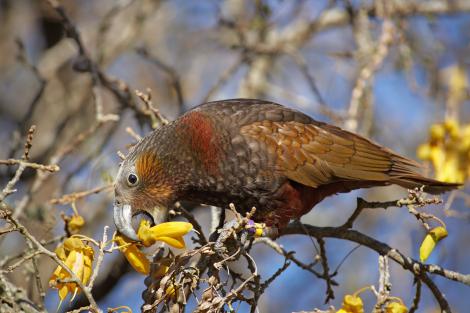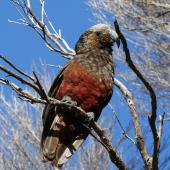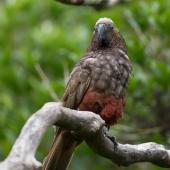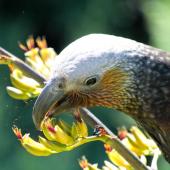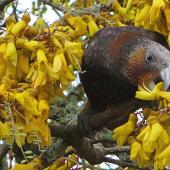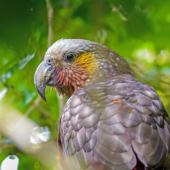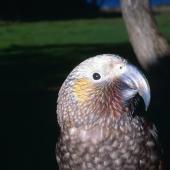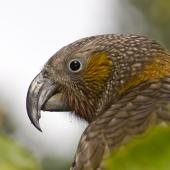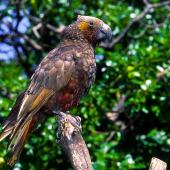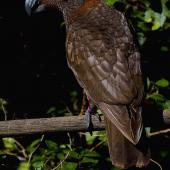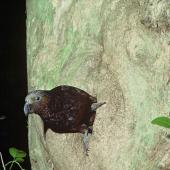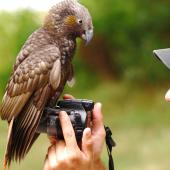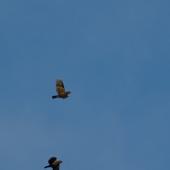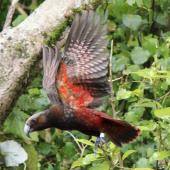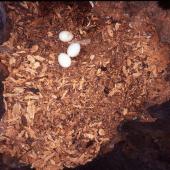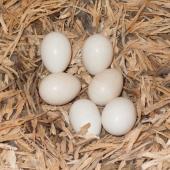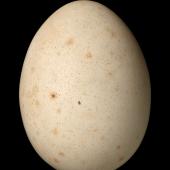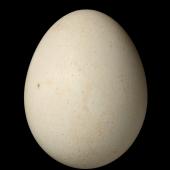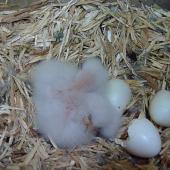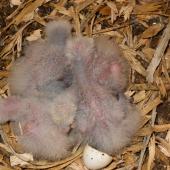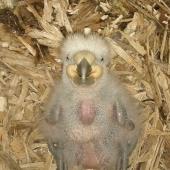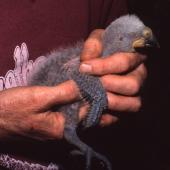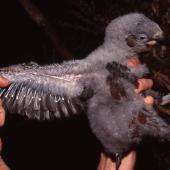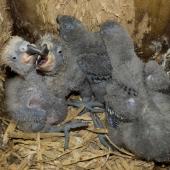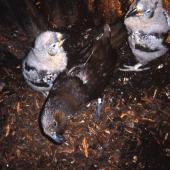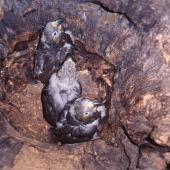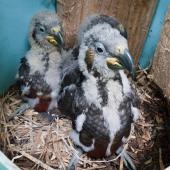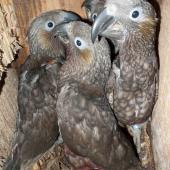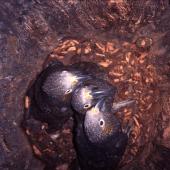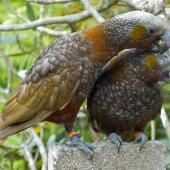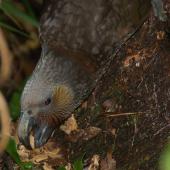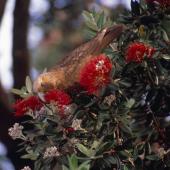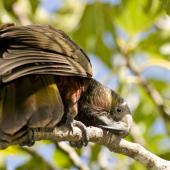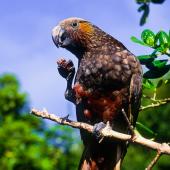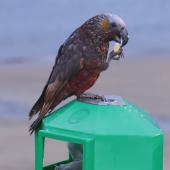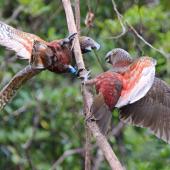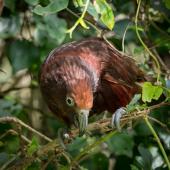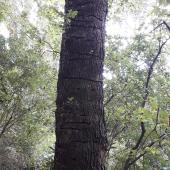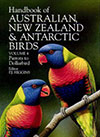Kākā | Kaka
Nestor meridionalis (Gmelin, 1788)
Order: Psittaciformes
Family: Strigopidae
New Zealand status: Endemic
Conservation status: Recovering
Other names: bush parrot, brown parrot, kawkaw
Geographical variation: North and South Island sub-species are recognised but this is not supported by genetic data. There is a trend towards greater size from north to south
Generally heard before they are seen, kaka are large, forest-dwelling parrots that are found on all three main islands of New Zealand and on several offshore islands. Much reduced in range and abundance in the North and South islands due to forest clearance and predation by introduced mammals, kaka are most abundant on offshore islands that have no introduced mammals, or at least no stoats. They remain locally common at some sites on the main islands that are close to offshore island refuges, and have increased in abundance at others where mammalian pests have been controlled. Kaka can be found in a wide variety of native forest types including podocarp and beech forest. They are a common sight in Wellington city, having spread from Zealandia / Karori Sanctuary.
Identification
A large, olive-brown parrot with grey-white crown, red-orange underwing and deep crimson belly and under-tail coverts. Males have a noticeably longer and deeper upper mandible and bigger head than females but this is generally only apparent when the two sexes are seen side by side.
Voice: a harsh, repeated, rhythmic “ka-aa” when flying above the forest canopy, harsh grating “kraak” alarm call when disturbed. Also a variety of loud, musical whistles, but these vary markedly from place to place. Males give a soft “tsee-tsee-tsee” call during the pre-copulatory display and when showing potential nest sites to females. Females soliciting food from their mates, and juveniles soliciting food from their parents, utter a guttural, repeated “aa-aa” call.
Similar species: the only species likely to be confused with the kaka is the kea, which is larger, olive-green rather than olive-brown, and confined to the South Island.
Distribution and habitat
Kaka are rare to uncommon in native forest throughout the three main islands of New Zealand except for areas adjacent to offshore island strongholds such as the Hen and Chicken Islands, Little Barrier Island, Kapiti Island, Ulva Island and Codfish Island. They are also common on Great Barrier and Mayor Islands, and have recovered at some sites where control of mammalian predators is undertaken, such as the Wangapeka valley in Kahurangi National Park, and the Eglinton Valley and Waitutu in Fiordland National Park. Reintroduction programmes have been remarkably successful at a few sites. A large wild kaka flock is a feature at the Pukaha Mt Bruce National Wildlife Centre in the Wairarapa, and kaka are commonly seen throughout the Wellington city green belt, following their reintroduction to Zealandia / Karori Sanctuary. Kaka also visit Auckland and Hamilton cities during winter, but there are few sites there where they are regularly seen.
Population
Probably fewer than 10,000 birds. There appears to be sufficient gene flow between most populations to prevent the development of significant genetic differences between them.
Threats and conservation
Although forest clearance has destroyed all but a fraction of the kaka’s former habitat, the biggest threat to their survival is introduced mammalian predators, particularly the stoat, but also the brushtail possum. It is predation by these pests, particularly of nesting females, that is the reason for general rarity of kaka on the main islands compared to their forested offshore island strongholds.Kaka can coexist with rats, and possibly also with possums, but not with stoats. Kaka populations can, however, recover when stoats and other pests are controlled by trapping or poisoning.
Breeding
Kaka mainly breed in spring and summer, but occasional second broods can extend breeding into winter. Nests are generally in tree cavities over 5 metres above the ground, but can be at ground level on offshore islands. The nest floor is lined with small wood chips. The typical clutch size is 4. The female alone incubates the eggs and cares for the nestlings but is fed by the male throughout the breeding season. Both parents feed the fledglings which often fledge before they are able to fly, or even climb, effectively.
Behaviour and ecology
Kaka are obligate forest birds that obtain all their food from trees. They are adept fliers, capable of weaving through trunks and branches, and can cover long distances, including over water. Radio-tracking and banding studies revealed that the kaka of the Hen and Chickens, Little Barrier and Great Barrier Islands are effectively one population, even though these islands are separated by as much as 25 km of open water. Kaka congregate at localised food sources such as flowering rata, but often forage alone for wood-boring insect larvae, fruit or seeds. As conspicuous as they can be when in a group, kaka are typically cryptic when alone, often the only thing to betray their presence is the sound of wood or seed fragments dropped by the bird as it forages.
Food
Kaka consume seeds, fruit, nectar, sap, honeydew and tree-dwelling, especially wood-boring, invertebrates. There are also two records of kaka preying on the eggs of small passerines. Kaka are seasonal specialists, moving from food source to food source as different fruits, seeds and nectar become available.
Weblinks
https://www.doc.govt.nz/nature/native-animals/birds/birds-a-z/kaka/
References
Dussex, N.; Sainsbury, J.; Moorhouse, R.; Jamieson, I.G.; Robertson, B.C. 2015. Evidence for Bergman’s Rule and not allopatric speciation in the threatened kaka (Nestor meridionalis). Journal of Heredity 106: 679-691.
Heather, B.D.; Robertson, H.A. 1996. The field guide to the birds of New Zealand. Auckland, Viking.
Higgins, P.J. (ed.) 1999. Handbook of Australian, New Zealand and Antarctic birds. Vol. 4, parrots to dollarbird. Oxford University Press.
Moorhouse, R.J. 1997. The diet of the North Island kaka (Nestor meridionalis septentrionalis) on Kapiti Island. New Zealand Journal of Ecology 21: 141-152.
Moorhouse, R.J.; Greene, T. 1995. Identification of fledgling and juvenile North Island kaka. Notornis 42: 187-196.
Moorhouse, R.; Greene, T.; Dilks, P.; Powlesland, R.; Moran, L.; Taylor, G.; Jones, A.; Knegtmans, J.; Wills, D.; Pryde, M.; Fraser, I.; August, A.; August, C. 2003. Control of introduced mammalian predators improves kaka Nestor meridionalis breeding success: reversing the decline of a threatened New Zealand parrot. Biological Conservation 110: 33-44.
Moorhouse, R.J.; Sibley, M.D.; Lloyd, B.D.; Greene, T.C. 1999. Sexual dimorphism in the North Island kaka Nestor meridionalis septentrionalis: selection for enhanced male provisioning ability? Ibis 141: 644-651.
Powlesland, R.G.; Greene, T.C.; Dilks, P.J.; Moorhouse, R.J.; Moran, L.R.; Taylor, G.; Jones, A.; Wills, D.E.; August, C.K.; August, A.C.L. 2009. Breeding biology of the New Zealand kaka (Nestor merdionalis) (Psittacidae, Nestorinae). Notornis 56: 11-33.
Robertson, H.A; Baird, K.; Elliott, G.P.; Hitchmough, R.A.; McArthur, N.J.; Makan, T.; Miskelly, C.M.; O’Donnell, C.F.J.; Sagar, P.M.; Scofield, R.P.; Taylor, G.A.; Michel, P. 2021. Conservation status of birds in Aotearoa New Zealand birds, 2021. New Zealand Threat Classification Series 36. Wellington, Department of Conservation. 43p.
Sainsbury, J. P.; Greene, T.C.; Moorhouse, R.J.; Daugherty, C.H.; Chambers, G.K. 2006. Microsatellite analysis reveals substantial levels of genetic variation but low levels of genetic divergence among isolated populations of kaka (Nestor meridionalis). Emu 106: 329-338.
Wilson, P.; Karl, B.; Toft, R.; Beggs, J.; Taylor, R. 1998. The role of introduced predators and competitors in the decline of kaka (Nestor meridionalis) populations in New Zealand. Biological Conservation 83: 175-185.
Recommended citation
Moorhouse, R.J. 2013 [updated 2022]. Kākā | Kaka. In Miskelly, C.M. (ed.) New Zealand Birds Online. www.nzbirdsonline.org.nz
Kākā | Kaka
- Social structure
- female-only incubation and brood-care
- Breeding season
-
- Jul
- Aug
- Sep
- Oct
- Nov
- Dec
- Jan
- Feb
- Mar
- Apr
- May
- Jun
- Nest type
- tree hole
- Nest height (mean)
- 29.3 m
- Nest height (min)
- 0 m
- Nest height (max)
- 54 m
- Maximum number of successful broods
- 2
- Clutch size (mean)
- 4.2
- Clutch size (min)
- 1
- Clutch size (max)
- 8
- Mean egg dimensions (length)
- 41.5 mm
- Mean egg dimensions (width)
- 31.5 mm
- Egg colour
- Dull white
- Egg laying dates
-
- Jul
- Aug
- Sep
- Oct
- Nov
- Dec
- Jan
- Feb
- Mar
- Apr
- May
- Jun
- Interval between eggs in a clutch
- 3.5 days days
- Incubation behaviour
- female only
- Incubation length (mean)
- 20.4 days (20.3-20.5) average of two clutches
- Nestling type
- altricial
- Nestling period (mean)
- 73 days
- Nestling period (min)
- 68 days
- Nestling period (max)
- 81 days
- Age at fledging (mean)
- 73 days
- Age at fledging (min)
- 68 days
- Age at fledging (max)
- 81 days
- Age at independence (mean)
- 2-5 months
- Age at first breeding (typical)
- 3 years
- Age at first breeding (min)
- 1 years
- Maximum longevity
- 42 years (captivity), anecdotal record Kapiti Island 27 years
- Maximum dispersal
- 400 km
North Island kaka
- Breeding season
-
- Jul
- Aug
- Sep
- Oct
- Nov
- Dec
- Jan
- Feb
- Mar
- Apr
- May
- Jun
- Egg laying dates
-
- Jul
- Aug
- Sep
- Oct
- Nov
- Dec
- Jan
- Feb
- Mar
- Apr
- May
- Jun
South Island kaka
- Breeding season
-
- Jul
- Aug
- Sep
- Oct
- Nov
- Dec
- Jan
- Feb
- Mar
- Apr
- May
- Jun
- Egg laying dates
-
- Jul
- Aug
- Sep
- Oct
- Nov
- Dec
- Jan
- Feb
- Mar
- Apr
- May
- Jun




